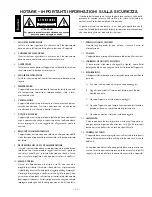
CIRCUIT OPERATION
trans•nova Implementation
The transistor Q1 is configured to operate as a switch which controls the current source, Q103, of the input differential
amp, Q6 and Q7. When Q1 is off the emitter voltage is low turning off Q103. Timing of the Soft Start function is controlled
by the charging time of C29 through R13. The THERMAL and OVERLOAD Protection circuits use Q1 to shut down the
channel when they activate.
U1A and U1B are buffer amps configured as unity gain, non-inverting voltage followers which feed the attenuator
network comprised of the level control R24A, and R24B and the resistor R6 which establishes the 60dB adjustment
range. The output of U2A and U1B is connected to the input of the differential amp. U2B is configured as a DC servo
integrator to null the input offset currents.
The output of the differential amp is fed to the driver stage by Q13 and Q14 which perform the DIAMOND
transconductance steering function. The cascode pairs Q9, Q10 and Q11, Q12 supply the signal voltage and current
needed to drive the output stage Q4, Q115, Q15, and Q116, Q5, Q16.
Class AB bias current is controlled by R136.
Loop feedback is supplied by the network R1 and C1, and global feedback by R10 and C8.
CALIBRATION
WARNING: Only a competent technician should attempt the following procedure.
PRECAUCION: Sólo un técnico competente debe intentar efetuar el siguiente procedimiento.
MISE EN GARDE: Seul un technicien compétent devrait procéder à l'opération suivante.
WARNUNG: Nur ein speziell geschulter Techniker sollte die nachfolgende Prozedur durchführen.
AVVISO: La seguente procedura va eseguita soltanta da un tecnico di competenza.
Bias:
The bias control establishes the quiescent Class AB output current of the amplifier. The bias should not need
readjustment from the factory setting; however, if the amplifier is repaired and output devices have been changed, or
if the two channels of the amplifier do not run at the same temperature, calibrating the bias is necessary. Disconnect
the power to the amplifier before removing the cover. To adjust the bias, disconnect the input and speakers and remove
the jumper JW7. Connect an amp meter across the exposed pins. Adjust R136 to get a current reading of 300 mA.
WARNING: Only a competent technician should attempt the following procedure.
PRECAUCION: Sólo un técnico competente debe intentar efetuar el siguiente procedimiento.
MISE EN GARDE: Seul un technicien compétent devrait procéder à l'opération suivante.
WARNUNG: Nur ein speziell geschulter Techniker sollte die nachfolgende Prozedur durchführen.
AVVISO: La seguente procedura va eseguita soltanta da un tecnico di competenza.
Calibrating Common Mode Rejection:
The input common mode null is adjusted by the trim pot R8. The CMRR should be greater than 75dB below rated output.
If the CMRR requires adjustment, feed the amplifier input with a common mode signal and adjust R8. Disconnect the
power to the amplifier before removing the cover. Use a sinewave generator set to 1 volt output at 1kHz. Connect the
generator signal output to the tip and ring of a 1/4" plug and ground to the sleeve. Plug this into the amplifier input.
Connect an AC voltmeter to the amplifier output binding posts. Adjust R8 to give the lowest voltage output from the
amplifier. For a temporary adjustment when a signal generator and voltmeter are not available, use an FM tuner and
tune it to an unused station as your signal source, and connect the signal to the amplifier as described above. Connect
the amplifier output to a small full range speaker. Turn the amplifier level controls full down and turn the amplifier on.
Turn up the level control until you hear a signal through the speaker. Alternate between adjusting R8 for the lowest output
signal and increasing the input control until you have the level control full. There should be very low output from the
amplifier if any is detected at all.
– 15 –
Содержание trans-nova P4000
Страница 16: ...12 PC BO A R D LA Y O U T PC 1487 C...










































